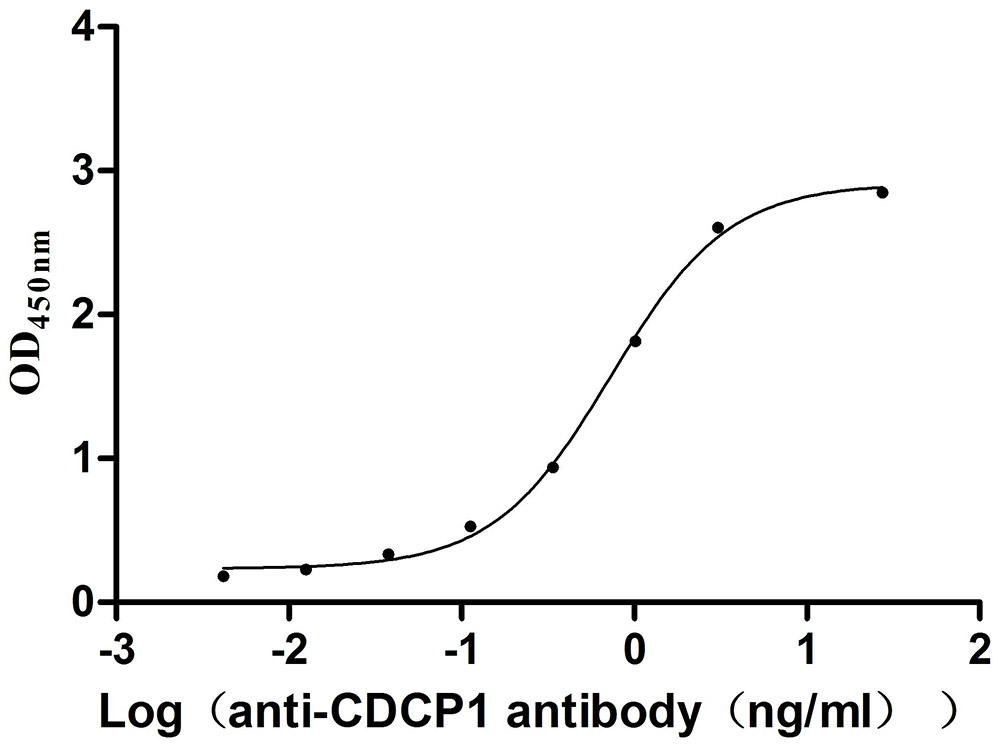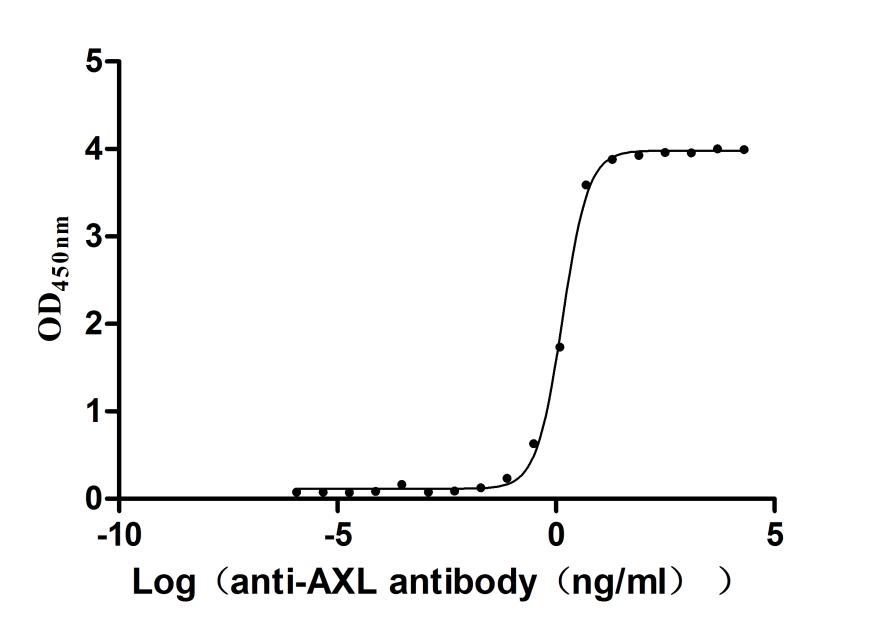Recombinant Human Poly (rC)-binding protein 2 (PCBP2)
-
货号:CSB-YP622995HU
-
规格:
-
来源:Yeast
-
其他:
-
货号:CSB-EP622995HU-B
-
规格:
-
来源:E.coli
-
共轭:Avi-tag Biotinylated
E. coli biotin ligase (BirA) is highly specific in covalently attaching biotin to the 15 amino acid AviTag peptide. This recombinant protein was biotinylated in vivo by AviTag-BirA technology, which method is BriA catalyzes amide linkage between the biotin and the specific lysine of the AviTag.
-
其他:
-
货号:CSB-BP622995HU
-
规格:
-
来源:Baculovirus
-
其他:
-
货号:CSB-MP622995HU
-
规格:
-
来源:Mammalian cell
-
其他:
产品详情
-
纯度:>85% (SDS-PAGE)
-
基因名:PCBP2
-
Uniprot No.:
-
别名:Alpha CP2; Alpha-CP2; alphaCP-2; Cbp; CTBP; Heterogeneous nuclear ribonucleoprotein E2; Heterogenous nuclear ribonucleoprotein E2; hnRNP E2; hnRNP-E2; HNRNPE2; Hnrnpx; HNRPE2; Hnrpx; MGC110998; PCBP2; PCBP2_HUMAN; poly(rC) binding protein 2; Poly(rC)-binding protein 2; Putative heterogeneous nuclear ribonucleoprotein X; rCbinding protein 2
-
种属:Homo sapiens (Human)
-
蛋白长度:full length protein
-
表达区域:1-365
-
氨基酸序列MDTGVIEGGL NVTLTIRLLM HGKEVGSIIG KKGESVKKMR EESGARINIS EGNCPERIIT LAGPTNAIFK AFAMIIDKLE EDISSSMTNS TAASRPPVTL RLVVPASQCG SLIGKGGCKI KEIRESTGAQ VQVAGDMLPN STERAITIAG IPQSIIECVK QICVVMLETL SQSPPKGVTI PYRPKPSSSP VIFAGGQDRY STGSDSASFP HTTPSMCLNP DLEGPPLEAY TIQGQYAIPQ PDLTKLHQLA MQQSHFPMTH GNTGFSGIES SSPEVKGYWG LDASAQTTSH ELTIPNDLIG CIIGRQGAKI NEIRQMSGAQ IKIANPVEGS TDRQVTITGS AASISLAQYL INVRLSSETG GMGSS
-
蛋白标签:Tag type will be determined during the manufacturing process.
The tag type will be determined during production process. If you have specified tag type, please tell us and we will develop the specified tag preferentially. -
产品提供形式:Lyophilized powder
Note: We will preferentially ship the format that we have in stock, however, if you have any special requirement for the format, please remark your requirement when placing the order, we will prepare according to your demand. -
复溶:We recommend that this vial be briefly centrifuged prior to opening to bring the contents to the bottom. Please reconstitute protein in deionized sterile water to a concentration of 0.1-1.0 mg/mL.We recommend to add 5-50% of glycerol (final concentration) and aliquot for long-term storage at -20℃/-80℃. Our default final concentration of glycerol is 50%. Customers could use it as reference.
-
储存条件:Store at -20°C/-80°C upon receipt, aliquoting is necessary for mutiple use. Avoid repeated freeze-thaw cycles.
-
保质期:The shelf life is related to many factors, storage state, buffer ingredients, storage temperature and the stability of the protein itself.
Generally, the shelf life of liquid form is 6 months at -20°C/-80°C. The shelf life of lyophilized form is 12 months at -20°C/-80°C. -
货期:Delivery time may differ from different purchasing way or location, please kindly consult your local distributors for specific delivery time.Note: All of our proteins are default shipped with normal blue ice packs, if you request to ship with dry ice, please communicate with us in advance and extra fees will be charged.
-
注意事项:Repeated freezing and thawing is not recommended. Store working aliquots at 4°C for up to one week.
-
Datasheet :Please contact us to get it.
相关产品
靶点详情
-
功能:Single-stranded nucleic acid binding protein that binds preferentially to oligo dC. Major cellular poly(rC)-binding protein. Binds also poly(rU). Negatively regulates cellular antiviral responses mediated by MAVS signaling. It acts as an adapter between MAVS and the E3 ubiquitin ligase ITCH, therefore triggering MAVS ubiquitination and degradation.; (Microbial infection) In case of infection by poliovirus, binds to the viral internal ribosome entry site (IRES) and stimulates the IRES-mediated translation. Also plays a role in initiation of viral RNA replication in concert with the viral protein 3CD.
-
基因功能参考文献:
- PCBP2 expression was markedly increased in higher stages of glioblastoma compared with those in lower stages; further research suggested that PCBP2 upregulation was connected with poorer prognosis in patients with glioblastoma PMID: 28787701
- Double immunofluorescence for hnRNP E2 and TDP-43 showed most TDP-43 immunopositive dystrophic neuritis within frontal and temporal cortex, and the neuronal cytoplasmic inclusions seen in dentate gyrus granule cells, to contain hnRNP E2. Present findings indicate an association between TDP-43 and hnRNP E2 which might underlie the pathogenetic mechanism of Semantic Dementia Frontotemporal Lobar Degeneration. PMID: 28666471
- Data suggest that the interaction between PCBP2 and the 3'UTR of the ARHGDIA mRNA may induce a local change in RNA structure that favors subsequent binding of miR-151-5p and miR-16, thus leading to the suppression of ARHGDIA expression. PMID: 26761212
- To promote intracellular iron flux, an iron chaperone appears to be essential for receiving iron from heme catabolism. Data suggest that PCBP2 competes with CPR for binding HO1; PCBP2 K homology 3 domain is important for HO1/PCBP2 interaction; heme prompts HO1/CPR multimer and decreases HO1/PCBP2 multimer. [PCBP2 = poly(rC) binding protein 2; CPR = cytochrome P450 reductase; HO1 = heme oxidase 1] PMID: 28655775
- Study determined that PCBP2 specifically associates with components of this kinase cascade and regulates the activities of its downstream transcriptional coactivators. PMID: 27215387
- These results suggest that FPN1 exports iron received from the iron chaperone PCBP2. Therefore, it was found that PCBP2 modulates cellular iron export, which is an important physiological process. PMID: 27302059
- PCBP2 was overexpressed in esophageal squamous cell carcinoma tissues and cell lines. PCBP2 expression promoted proliferation of ESCC cells. We also found that reduced PCBP2 expression might induce ESCC cell apoptosis with increased cleaved caspase3 expression. Overall, our findings indicated that PCBP2 might be involved in the ESCC progression and be considered as a new treatment target in ESCC. PMID: 27461833
- High expression of PCBP2 may contribute to sorafenib resistance in hepatocellular carcinoma cells. PMID: 27748915
- our data indicate that miR-214 may function as tumor suppressor in glioma by targeting PCBP2 PMID: 26722446
- PCBP2 knockdown promoted angiotensin II-induced hypertrophy (increase in cell size, protein synthesis and activation of fetal genes) of cardiomyocytes, while PCBP2 overexpression obtained oppose effects. PMID: 26116532
- Protein and mRNA levels of PCBP2 were down-regulated under insulin-resistant conditions. Over-expression of PCBP2 inhibits HIF1alpha and STAT3 pathway. PMID: 26002461
- STAT3 functions via cellular PCBP2 to regulate B-cell lytic susceptibility by restraining Epstein-Barr Virus lytic activation. PMID: 25717101
- PCBP2-depletion induces apoptosis in gastric cancer cells via up-regulating expression of pro-apoptotic proteins and down-regulating anti-apoptotic proteins. miR-34a is a target of PCBP2, and miR-34a is critically essential for the function of PCBP2. PMID: 24796666
- SIRT6 inhibits glioma cell proliferation and colony formation in vitro and glioma cell growth in vivo in a PCBP2 dependent manner. SIRT6 inhibits PCBP2 expression through deacetylating H3K9ac and SIRT6 acts as a tumor suppressor in glioma. PMID: 24607900
- Inhibition of poliovirus-induced cleavage of cellular PCBP2 protein reduces the viral RNA replication. PMID: 24371074
- PCBP2 and PTB are differentially cleaved by human rhinovirus proteinase in infected cells. PMID: 24418535
- PCBP2 controls the 3' processing of its own transcript. PMID: 23629627
- PCBP2 is an RNA-binding protein that modulates glioma growth by regulating FHL3 PMID: 23585479
- Cytosolic iron may modulate the association between PCBP2 and Dicer, as well as the multimerization of PCBP2 and its ability to bind to miRNA precursors PMID: 22633452
- PCBP2 specifically and selectively interacts with rabies virus glycoprotein mRNA and this interaction may contribute to the post-transcriptional regulation of glycoprotein expression PMID: 22438951
- PCBP2 stabilizes the mRNA of STAT1 and STAT2 through binding the 3'Untranslated Region (UTR) of these two molecules. PMID: 22022391
- SRp75 inhibits splicing of tau exon 10 by binding to the CA repeat in the intronic splicing silencer downstream of the exon, and requires hnRNPG to exert its full regulatory effect on tau exon 10. PMID: 21723381
- study demonstrates the mechanism of the participation of PCBP2 in hepatitis C virus translation and replication PMID: 21632751
- Study reports that loss of miR-328 occurs in blast crisis chronic myelogenous leukemia (CML-BC) in a BCR/ABL dose- and kinase-dependent manner through the MAPK-hnRNP E2 pathway. PMID: 20211135
- The s established that the 5'CL-PCBP complex is required for optimal poliovirus viral RNA translation and identified the KH3 domain of PCBP2 as the functional region. PMID: 19945132
- specific PCBP2 domains may have distinct roles for differential picornavirus template utilization during viral translation and RNA replication PMID: 12414943
- Data suggest that poly(C)-binding protein 2 KH domain 1 interactions with telomeric DNA and telomerase RNA may be involved in the regulation of telomere/telomerase functions. PMID: 15331611
- PCBP2 KH1 binds to C-rich strand of human telomeric DNA, indicating that that PCBPs may participate in mechanisms involved in the regulation of telomere/telomerase functions PMID: 16186123
- 2',5'-oligoadenylate synthetase activation may occur in prostate cancer cells stimulated by cellular mRNAs for PCBP2. PMID: 17145707
- Downregulation of HnRNP E2 is associated with oral cancer PMID: 17219427
- molecular model of the interaction of the third KH domain of human poly(C)-binding protein-2 in complex with a C-rich strand of human telomeric DNA. PMID: 17426136
- Crystal structures of PCBP2 KH1 domain in complex with a 12-nucleotide DNA corresponding to two repeats of the human C-rich strand telomeric DNA and its RNA equivalent. PMID: 17526645
- Study shows that through the loss of the KH3 domain, and therefore loss of its ability to function in translation, PCBP2 can mediate the switch from viral translation to RNA replication. PMID: 17581994
- The interaction of PCBP2 with RNA target sequences at the 5' end of the coxsackievirus B3 genome was investigated. PMID: 18086560
- PCBP2 may be involved in stress-induced remodeling of mRNP complexes and that it may also play a role in the rapid transition of certain silenced mRNAs into a translationally active state. PMID: 18174314
- Using a novel protein-RNA tethering system, We establish PCBP2 as an essential co-factor in the initiation of poliovirus negative-strand synthesis. PMID: 18252259
- The s showed that the PCBP2 linker domain modulates binding to poliovirus stem-loop IV RNA via a mechanism that is not inhibited by the antibody. PMID: 18656221
- SIN1 and PCBP2 are generally coregulated with large numbers of genes implicated in both cell survival and death and in cellular stress responses, including RNA translation and processing PMID: 18687895
- analysis of the human poly(C)-binding protein containing the first and second KH domains reveals insights into its regulatory mechanisms PMID: 18701464
- The data demonstrate interaction of isolated PCBP2 KH1 and KH3 domains to four distinct target sites within the 5'-nontranslated region of the CVB3 genomic RNA. PMID: 18929541
- Results establish the compositional diversity among P-bodies, and that PCBP2, probably in complex with other mRNP factors, may dynamically recognize such differences and accumulate to specific P-bodies. PMID: 19230839
- PCBP2-AIP4 axis defines a new signaling cascade for MAVS degradation and 'fine tuning' of antiviral innate immunity. PMID: 19881509
- validated occurrence of an unusual TG 3' splice site in intron 7 PMID: 17672918
显示更多
收起更多
-
亚细胞定位:Nucleus. Cytoplasm. Note=Loosely bound in the nucleus. May shuttle between the nucleus and the cytoplasm.
-
组织特异性:Detected in all tissues examined.
-
数据库链接:
HGNC: 8648
OMIM: 601210
KEGG: hsa:5094
STRING: 9606.ENSP00000352438
UniGene: Hs.546271
Most popular with customers
-
Recombinant Human Semaphorin-4D (SEMA4D), partial (Active)
Express system: Mammalian cell
Species: Homo sapiens (Human)
-
Recombinant Human Nectin-4 (NECTIN4), partial (Active)
Express system: Mammalian cell
Species: Homo sapiens (Human)
-
Recombinant Macaca fascicularis Membrane spanning 4-domains A1 (MS4A1)-VLPs (Active)
Express system: Mammalian cell
Species: Macaca fascicularis (Crab-eating macaque) (Cynomolgus monkey)
-
Recombinant Mouse CUB domain-containing protein 1 (Cdcp1), partial (Active)
Express system: Mammalian cell
Species: Mus musculus (Mouse)
-
Recombinant Mouse Cytotoxic and regulatory T-cell molecule (Crtam), partial (Active)
Express system: Mammalian cell
Species: Mus musculus (Mouse)
-
Recombinant Macaca fascicularis Zinc transporter ZIP6 isoform X1(SLC39A6),partial (Active)
Express system: Baculovirus
Species: Macaca fascicularis (Crab-eating macaque) (Cynomolgus monkey)
-
Recombinant Human Tyrosine-protein kinase receptor UFO(AXL),partial (Active)
Express system: Mammalian cell
Species: Homo sapiens (Human)



















